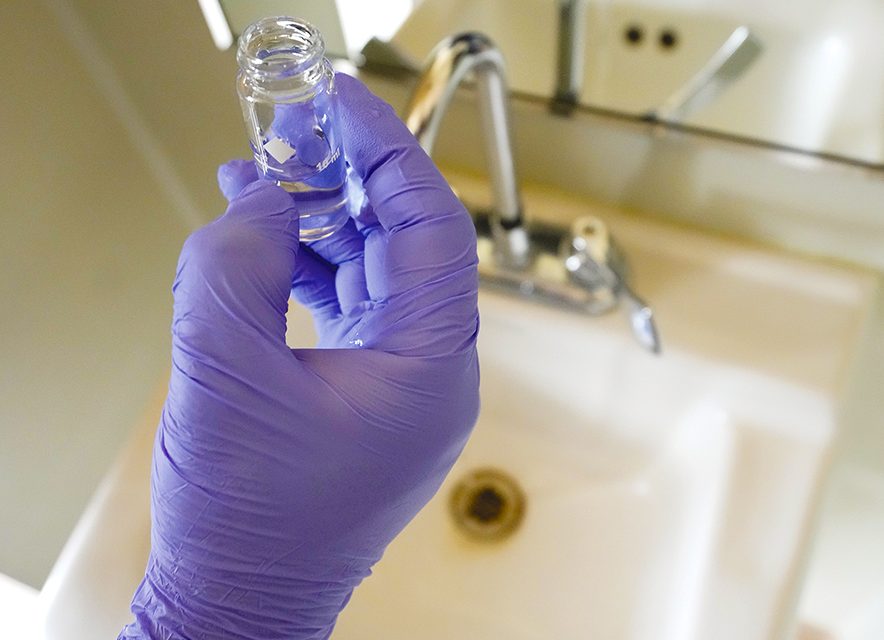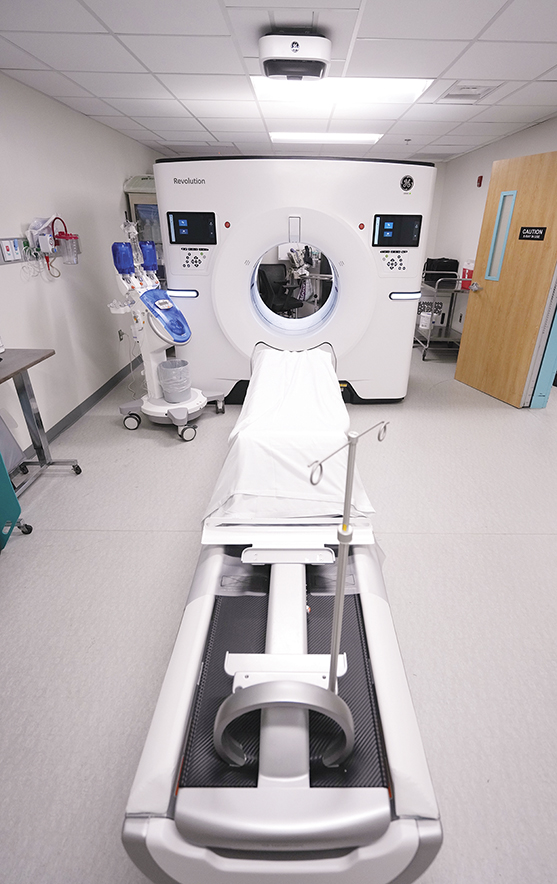
Gallup Indian Medical Center in line for $1.2 billion replacement

Special to the Times | Donovan Quintero
A vial, filled with 10 milliliters of a water sample, is checked for legionella during a testing of the Gallup Indian Medical Center’s water on Aug. 1 in Gallup.
By Donovan Quintero
Special to the Times
WINDOW ROCK — Outdated, the country’s largest Indian Health Service, faces a plethora of problems that could potentially cause it to create greater unsafe conditions for Navajo patients.
Even as a need for a new facility has been in the works since 1993, Gallup Indian Medical Center has fallen through the cracks. For 31 years, GIMC was placed on a priority list, but with no official site yet chosen — until a few weeks ago — plans to replace the old hospital never began.

Special to the Times | Donovan Quintero
A vial, filled with 10 milliliters of a water sample, is checked for legionella during a testing of the Gallup Indian Medical Center’s water on Aug. 1 in Gallup.
Amid crucial infrastructure breakdowns and health hazards, the healthcare facility is facing an uphill battle to secure funding for the construction of a new facility. GIMC has encountered a series of challenges, including the discovery of the potentially dangerous bacteria, Legionella, in its old water pipes.
The presence of Legionella in the aging water pipes poses a significant risk to the health of elderly patients at the medical center. Legionella bacteria can cause Legionnaires’ disease, a severe form of pneumonia that can be particularly harmful to individuals with weakened immune systems. The situation has raised concerns about the safety and well-being of patients and staff at the facility.
It is possible to rid the bacteria once and for all, but it would require extensive construction work on the old water piping system and that could unravel bigger unknown problems, said GIMC Maintenance Mechanic Supervisor Benjamin Williams on Aug. 1.
“We can but we’d have to reconfigure everything and shut down the facility,” Williams said of replacing the hospital’s aged water piping system, adding it could also create unknown challenges.
Adding chlorine to the system also was not an option because the hospital gets its water from the city of Gallup. That meant the water came through the hospital and went back into the city’s water supply structure.
Williams said the original water piping system was made of galvanized piping but that was replaced with copper throughout the hospital.
“All these valves were top of the line back then, now they’re obsolete,” he said.
Testing water for legionella
With no other options that would prevent the facility from being forced to shut down for a long-extended period to replace the piping, the hospital regularly tests its water for legionella.
Deputy CEO Dr. Jordon Begay, who’s been on the job for two years, said the maintenance staff is tasked with conducting random testing of the hospital’s water.

Special to the Times | Donovan Quintero
A medical resonance imaging, or MRI, which is used in radiology to form pictures of the inside of the human body, sits inside the Gallup Indian Medical Center Emergency Department, which is still under construction. The new ED will alleviate the overcrowded older emergency department when it becomes fully operational.
“So, they do our daily water testing,” said Begay, as he explained how equipment in hospital rooms is replaced as part of their mitigation program to prevent the spread of legionella. “We need to make sure the water is being pushed through. And then the nursing division also have stuff in place where they’re flushing the water on the different units.”
Legionella is a bacterium that thrives and multiplies in water where temperatures range between 68- and 113-degrees Fahrenheit, according to the Centers for Disease and Control Prevention. Infection occurs when a person inhales small water droplets containing the bacteria.
Exposure to Legionella bacteria poses a high risk of contracting Legionnaires’ disease, a severe form of pneumonia characterized by lung inflammation. Additionally, Legionella can cause a milder illness known as Pontiac Fever, which manifests with flu-like symptoms and usually resolves without treatment. However, Legionnaires’ disease is far more serious and, if left untreated, can be fatal.
Legionella is naturally found in freshwater environments such as lakes, rivers, and streams, where it poses no significant threat. The danger arises when the bacteria infiltrate man-made water systems, including water faucets, shower heads, hot tubs, hot water tanks, water heaters, cooling towers, and plumbing systems. Several conditions can facilitate the spread of Legionella in these settings. A key factor is the failure of water disinfection systems; if water flow is interrupted, disinfectant levels drop, or plumbing becomes stagnant, Legionella can rapidly colonize a water piping system.
Water temperature is crucial in controlling Legionella growth since the bacteria thrive in temperatures between 68- and 113-degrees Fahrenheit. To prevent Legionella proliferation, the CDC cites water temperatures should be maintained either below 65 degrees or above 122 degrees Fahrenheit. But while the bacteria do not die off below 68 degrees, the bacteria become inactive and cease to multiply, reducing the immediate risk of infection.
A trio of medical professionals who did not want to be identified for fear of retaliation became concerned over the increased breakdowns Gallup Indian Medical Center began experiencing.
Read the full story in the Aug. 15, edition of the Navajo Times.








 Highway 264,
Highway 264, I-40, WB @ Winslow
I-40, WB @ Winslow